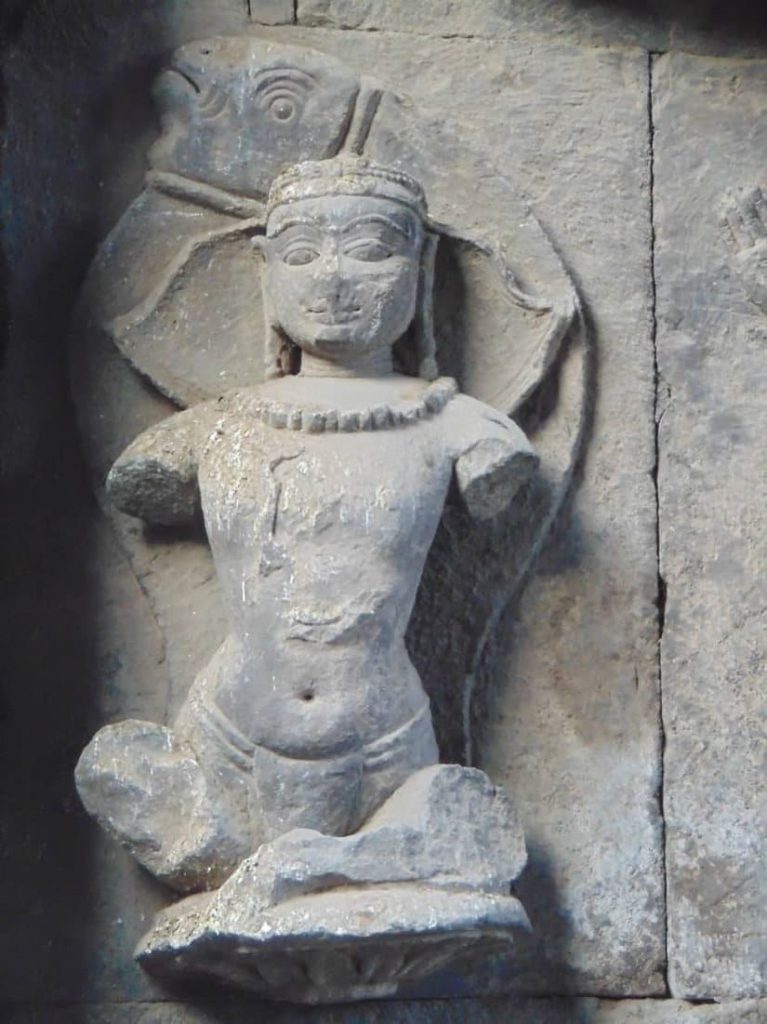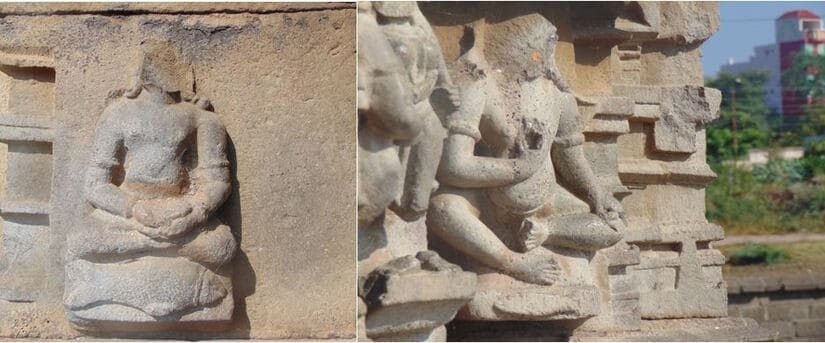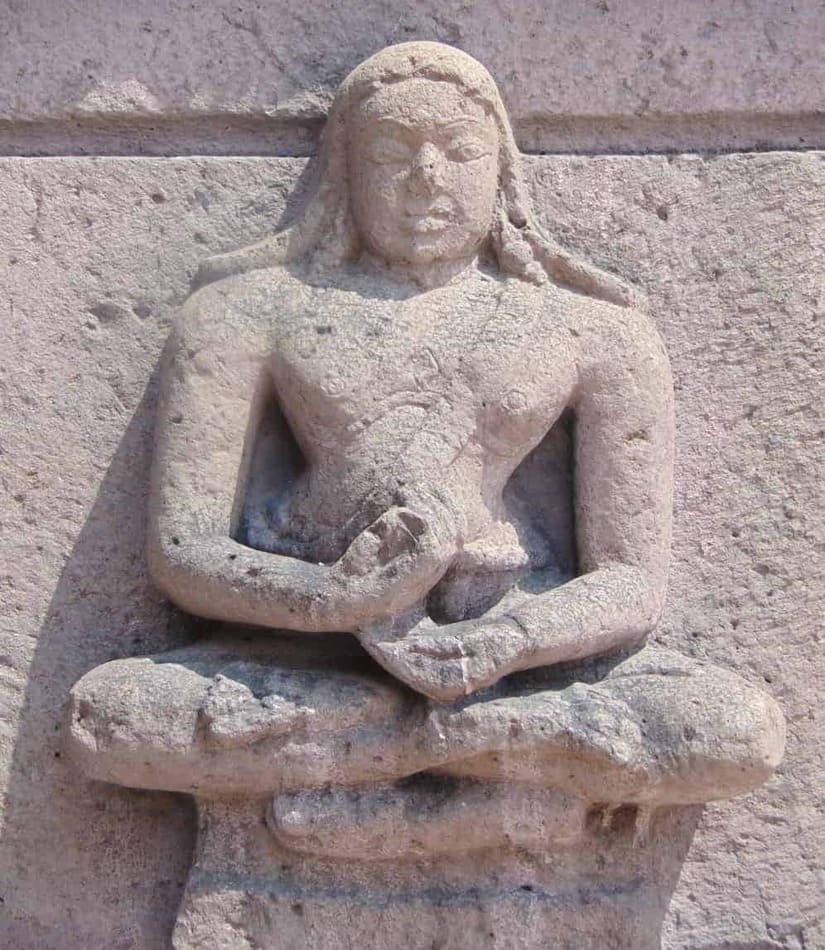Showcasing some of the earliest sculpture of the great Natha yogi Matsyendranatha.
Yogi Matsyendranatha in Stone
Showcasing some of the earliest sculpture of the great Natha yogi Matsyendranatha.
7 mins read
October 25, 2021

Showcasing some of the earliest sculpture of the great Natha yogi Matsyendranatha.

Matsyendranātha is considered the first Gurū of the Nātha sampradāya. According to the tradition, he had encompassed the knowledge revealed by Ādinātha (Śiva) during his conversation with Girijā, disguised as a fish. Therefore, all the names of Matsyendranātha are piscine-related. Matsyendranātha has numerous names such as Macchanda in Tantrāloka (written at the end of the 10th century by the Great Abhinavagupta); also, Macchaghnapāda, Macchendrapāda, Matsyendrapāda, Mīnapāda, Mīnanātha, Macchendapāda, Matsyendra, and Macchindranāthapāda.1Bagchi, P.C. 1934. Kaulajñāna-nirṇaya and Some Minor Texts of the School of Matsyendranātha (ed.). Calcutta: Metropolitan Printing and Publishing House Ltd.
Matsyendranātha is considered the first Gurū of the Nātha sampradāya. According to the tradition, he had encompassed the knowledge revealed by Ādinātha (Śiva) during his conversation with Girijā, disguised as a fish. Therefore, all the names of Matsyendranātha are piscine-related. Matsyendranātha has numerous names such as Macchanda in Tantrāloka (written at the end of the 10th century by the Great Abhinavagupta); also, Macchaghnapāda, Macchendrapāda, Matsyendrapāda, Mīnapāda, Mīnanātha, Macchendapāda, Matsyendra, and Macchindranāthapāda.1Bagchi, P.C. 1934. Kaulajñāna-nirṇaya and Some Minor Texts of the School of Matsyendranātha (ed.). Calcutta: Metropolitan Printing and Publishing House Ltd.

Matsyendra is also associated with many other sects and beliefs. He is one of the most prominent siddhas in the list of 84 siddhas, which is prevalent among both Śaiva and the Buddhist tradition of siddhas. He is considered to be the progenitor of the Kaula Yoginī sect. According to tradition, he is the gurū of Gorakṣanātha. In Nepali legends, he is an incarnation of Avalokiteśvara, a Buddhist deity, while in the later texts he is considered as an incarnation of Viṣṇu.2Dhere, R.C. 2010. Nātha Sampradāyācā Itihās (In Marathi). Pune: Padmagandha Prakashan. Hundreds of popular fables feature his name throughout India. It is said that his disciple, Gorakṣanātha, rescued Matsyendranātha from various antinomian tantric practices and helped steer him to the more ascetic practice of haṭha yoga. Matsyendranātha is also credited with composing tantric and yogic texts which include the Kaulajñānanirṇaya, Akulavīratantra, Matsyendrasaṃhitā, Candrāvalokana, and Yogaviṣaya.
Images of Matsyendranātha are mainly depicted on Śaiva, Śākta, and Vaiṣṇava temples, caves, and puṣkaraṇī (step-wells). These images can be found all across India but more so in Maharashtra, which indicates how universal his recognition was in the area. Images have considerable variation in size, shape, postures, and mudras. Early ones are relatively small, while in the later period, they became larger. He is always shown with two hands and mounted on a fish. He is often shown in siddhāsana, padmāsana, and paryaṅkāsana and in jñāna and dhyānamudrā. Fish is a common iconographical symbol of Matsyendranātha.3Sarde, Vijay 2019. Archaeological Investigations of The Natha Sampradaya in Maharashtra (12th to 15th century), Unpublished thesis submitted to the Deccan College, PGRI, Pune.

Several early images of Matsyendranātha are also noticed from Madhya Pradesh and Gujarat (the above image is that of Matsyendranāth in Mahudi Gate, Dabhoi, Gujarat). Three images of Matsyandranātha are shown on the rājasenaka row of the Surya and Viṣṇu Devī Jagadaṁbā temples at Khajuraho (constructed 1000-1025 C.E.).4Desai, D. 1996. The Religious Imagery of Khajuraho. Mumbai: Project for Indian Cultural Studies Publication IV. A sandstone image from Div in Saurashtra dating to the 11th century C.E has been identified as belonging to Matsyendranātha.5Parekh, V. S. 1978. The Iconography of Śaiva Deities from Gujarat. PhD. Thesis. Baroda: Maharaja Sayajirao University.
Matsyendranātha is shown with a fish, yajñopavita, keyūra, valaya, hāra, kaupina, karṇakuṇḍala, śṛṅgī, headgear, and elongated jaṭās—all of these being unique iconographic elements usually associated with siddhas and Nātha yogīs in archaeological sources. Some of the earliest images of Matsyendranātha in Maharashtra are carved on temples such as the Māṇakeśvara temple at Jhodge, the Kaṅkāleśvara temple at Beed, the Mahādeva temple at Mankeshvar, and the Nāganātha temple at Aundha (images are shown below). As these temples are all assigned to the 12th century, the images are some of the earliest representations of Matsyendranātha. Here are some of these earliest-known images of Matsyendranātha.

Matsyendranatha in Māṇakeśvara temple at Jhodge: Matsyendranātha is depicted on the devakoṣṭha, which shows his significance. The image is small, fragile, and defaced. He is depicted with karṇakuṇḍala. He places his right foot on the ground, and his left hand is on the knee. He is shown seated in a beautiful decorative toraṇa.

Matsyendranāth in Nāganātha temple at Aundha: This is a small image of Matsyendranātha sitting in Padmāsana with a fish carved below. As can be seen, the image has suffered a lot of wear and tear.

Matsyendranātha in Mahādeva temple at Mankeshvar: Matsyendranātha is shown seated on a fish with yogapaṭṭa tied around his left leg. His right hand is shown in bhūmisparśamudrā.

Matsyendranātha in Kaṅkāleśvara temple at Beed: Two images of Matsyendranātha have been carved on this temple. In the first image, he is shown in a seated posture with a fish carved below his seat, a symbol that confirms this image as that of Matsyendranātha. The image’s face has been mutilated, but the karṇakuṇḍala are visible and hanging over the shoulder. His right hand is placed near the chest holding an unknown object while another hand is placed on the knee of the left leg holding a śṛṅgī. He is shown with keyūra and hairdress. In the second image, he is also shown with a fish as a mound. In this image, He is seated in dhyāna mudrā (most of the images of all the temples including Matsyendranātha were defaced by the invaders in the later period)

Matsyendranātha in Someśvara temple at Pimpri Dumala: There is a frontal representation of Matsyendranātha seated in padmāsana on the western side of the outer wall of guḍhamaṇḍapa. His right hand is in vyākhyānamudrā and his left hand is above his soles to support the right hand. He has probably a kaupina tied by mekhalā perhaps made of woollen strings. He has a yajñopavita placed across his left shoulder and around the waist. He has his hair falling on either side. His ear ornaments are clearly depicted and his large pierced ear lobes almost reach his shoulder. There is a small depiction of a fish on the pedestal.
This is just a small sample of Matsyendranātha iconography. In the later centuries, Matsyendranātha’s archaeological presence is found all across the Indian sub-continent, turning more ornate as the Nātha sampradāya becomes one of the most dominant Śaiva yogī traditions in India.

Matsyendra is also associated with many other sects and beliefs. He is one of the most prominent siddhas in the list of 84 siddhas, which is prevalent among both Śaiva and the Buddhist tradition of siddhas. He is considered to be the progenitor of the Kaula Yoginī sect. According to tradition, he is the gurū of Gorakṣanātha. In Nepali legends, he is an incarnation of Avalokiteśvara, a Buddhist deity, while in the later texts he is considered as an incarnation of Viṣṇu.2Dhere, R.C. 2010. Nātha Sampradāyācā Itihās (In Marathi). Pune: Padmagandha Prakashan. Hundreds of popular fables feature his name throughout India. It is said that his disciple, Gorakṣanātha, rescued Matsyendranātha from various antinomian tantric practices and helped steer him to the more ascetic practice of haṭha yoga. Matsyendranātha is also credited with composing tantric and yogic texts which include the Kaulajñānanirṇaya, Akulavīratantra, Matsyendrasaṃhitā, Candrāvalokana, and Yogaviṣaya.
Images of Matsyendranātha are mainly depicted on Śaiva, Śākta, and Vaiṣṇava temples, caves, and puṣkaraṇī (step-wells). These images can be found all across India but more so in Maharashtra, which indicates how universal his recognition was in the area. Images have considerable variation in size, shape, postures, and mudras. Early ones are relatively small, while in the later period, they became larger. He is always shown with two hands and mounted on a fish. He is often shown in siddhāsana, padmāsana, and paryaṅkāsana and in jñāna and dhyānamudrā. Fish is a common iconographical symbol of Matsyendranātha.3Sarde, Vijay 2019. Archaeological Investigations of The Natha Sampradaya in Maharashtra (12th to 15th century), Unpublished thesis submitted to the Deccan College, PGRI, Pune.

Several early images of Matsyendranātha are also noticed from Madhya Pradesh and Gujarat (the above image is that of Matsyendranāth in Mahudi Gate, Dabhoi, Gujarat). Three images of Matsyandranātha are shown on the rājasenaka row of the Surya and Viṣṇu Devī Jagadaṁbā temples at Khajuraho (constructed 1000-1025 C.E.).4Desai, D. 1996. The Religious Imagery of Khajuraho. Mumbai: Project for Indian Cultural Studies Publication IV. A sandstone image from Div in Saurashtra dating to the 11th century C.E has been identified as belonging to Matsyendranātha.5Parekh, V. S. 1978. The Iconography of Śaiva Deities from Gujarat. PhD. Thesis. Baroda: Maharaja Sayajirao University.
Matsyendranātha is shown with a fish, yajñopavita, keyūra, valaya, hāra, kaupina, karṇakuṇḍala, śṛṅgī, headgear, and elongated jaṭās—all of these being unique iconographic elements usually associated with siddhas and Nātha yogīs in archaeological sources. Some of the earliest images of Matsyendranātha in Maharashtra are carved on temples such as the Māṇakeśvara temple at Jhodge, the Kaṅkāleśvara temple at Beed, the Mahādeva temple at Mankeshvar, and the Nāganātha temple at Aundha (images are shown below). As these temples are all assigned to the 12th century, the images are some of the earliest representations of Matsyendranātha. Here are some of these earliest-known images of Matsyendranātha.

Matsyendranatha in Māṇakeśvara temple at Jhodge: Matsyendranātha is depicted on the devakoṣṭha, which shows his significance. The image is small, fragile, and defaced. He is depicted with karṇakuṇḍala. He places his right foot on the ground, and his left hand is on the knee. He is shown seated in a beautiful decorative toraṇa.

Matsyendranāth in Nāganātha temple at Aundha: This is a small image of Matsyendranātha sitting in Padmāsana with a fish carved below. As can be seen, the image has suffered a lot of wear and tear.

Matsyendranātha in Mahādeva temple at Mankeshvar: Matsyendranātha is shown seated on a fish with yogapaṭṭa tied around his left leg. His right hand is shown in bhūmisparśamudrā.

Matsyendranātha in Kaṅkāleśvara temple at Beed: Two images of Matsyendranātha have been carved on this temple. In the first image, he is shown in a seated posture with a fish carved below his seat, a symbol that confirms this image as that of Matsyendranātha. The image’s face has been mutilated, but the karṇakuṇḍala are visible and hanging over the shoulder. His right hand is placed near the chest holding an unknown object while another hand is placed on the knee of the left leg holding a śṛṅgī. He is shown with keyūra and hairdress. In the second image, he is also shown with a fish as a mound. In this image, He is seated in dhyāna mudrā (most of the images of all the temples including Matsyendranātha were defaced by the invaders in the later period)

Matsyendranātha in Someśvara temple at Pimpri Dumala: There is a frontal representation of Matsyendranātha seated in padmāsana on the western side of the outer wall of guḍhamaṇḍapa. His right hand is in vyākhyānamudrā and his left hand is above his soles to support the right hand. He has probably a kaupina tied by mekhalā perhaps made of woollen strings. He has a yajñopavita placed across his left shoulder and around the waist. He has his hair falling on either side. His ear ornaments are clearly depicted and his large pierced ear lobes almost reach his shoulder. There is a small depiction of a fish on the pedestal.
This is just a small sample of Matsyendranātha iconography. In the later centuries, Matsyendranātha’s archaeological presence is found all across the Indian sub-continent, turning more ornate as the Nātha sampradāya becomes one of the most dominant Śaiva yogī traditions in India.
Showcasing some of the earliest sculpture of the great Natha yogi Matsyendranatha.
Old temples reveal the rich tapestry of religious life in medieval Maharashtra.
Who is Shiva? Can he exist without Shakti? But who is Shakti if not Shiva?
History
Yoga & Meditation
Religion & Philosophy

Leave a Reply